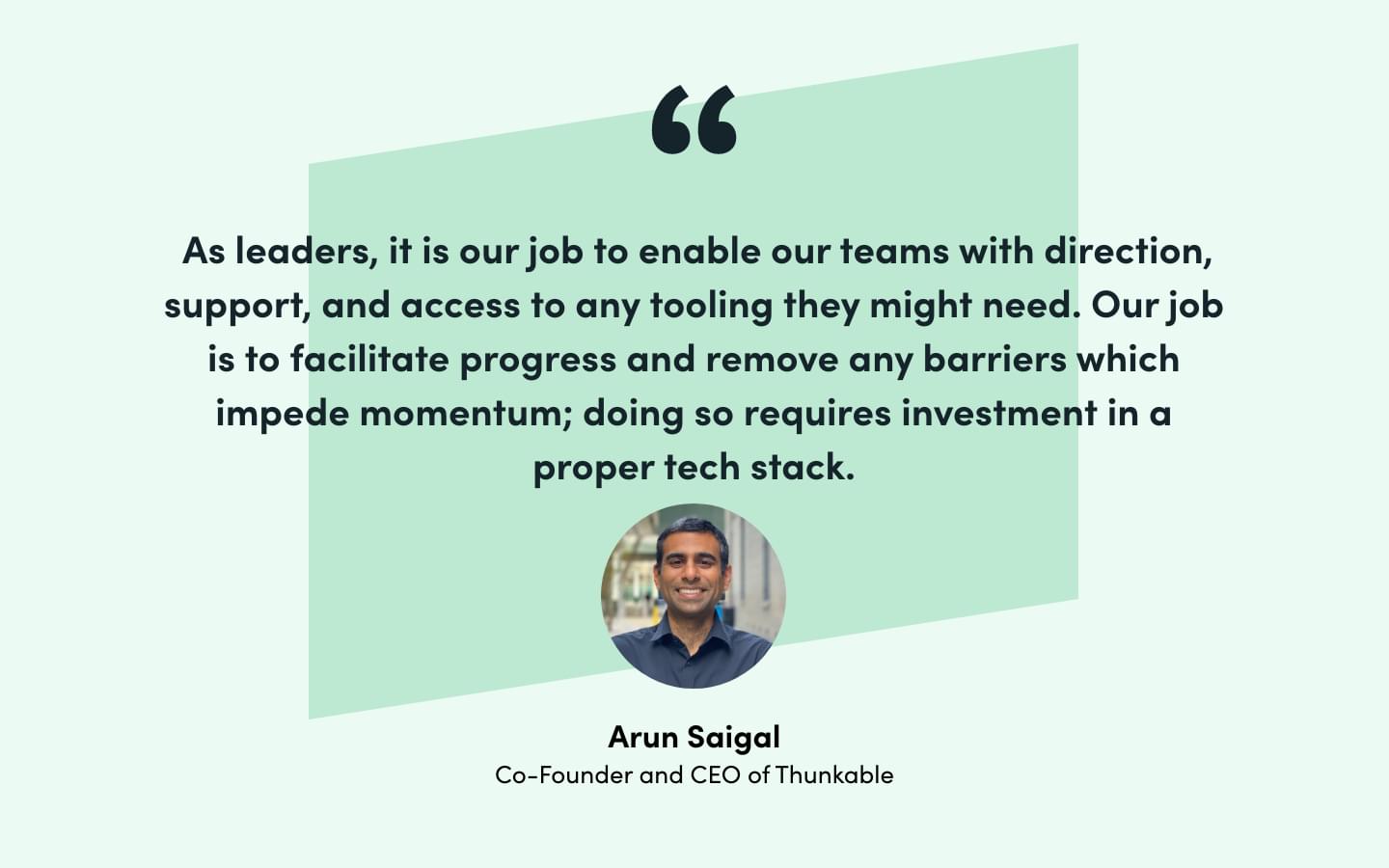I want to share a story about an unexpected mishap in the orchestral world that got me thinking about business operations.
At the Mondavi Center’s 20th anniversary celebration, more than a thousand guests gathered to hear the award-winning San Francisco Symphony conducted by a Grammy Award-winning musician. Excitement soon turned to disappointment, however. While the conductor and musicians were prepared for the show, their instruments and sheet music were not.
The cause? A traffic circle and shrubbery had stalled the truck carrying the symphony’s sheet music and musical instruments on the highway. As a last resort, the show was canceled due to the orchestra being without the necessary equipment.
As a conductor myself, I would feel mortified if this unlikely mishap happened with my orchestra. Yet, as the CEO of a startup, I am often astounded to find employees expected to work without the proper tools, just like musicians left without their instruments.
Teams without the necessary tools or, worse, no tools at all, are prevented from executing their talent and doing their best work. Essentially, they’re musicians without their instruments.
The Need for an Optimized Tech Stack
Formstack's 2022 State of Digital Maturity report found 64% of employees surveyed who don't have access to no-code tools want to use them. Why does this matter?
Well, the report identified different levels of digital maturity among organizations. Those with the least digital maturity were labeled as “Limited” organizations, defined as being stuck in a status quo, reliant on manual processes, and having a limited tech stack, which often results in a reluctance to adopt new technical tools.
Meanwhile, "Optimized” organizations have digitized their workflows, possess a well-integrated tech stack, and continuously test new technology to improve internal operations. Optimized organizations will invest in tech tools consistently, as opposed to Limited organizations, which will only adopt technology when issues arise and do not consider long-term plans when making these digital purchases.
Why does this matter for executives? As leaders, it is our job to enable our teams with direction, support, and access to any tooling they might need. Our job is to facilitate progress and remove any barriers which impede momentum; doing so requires investment in a proper tech stack.

The need for technical adaptability and providing teams with the necessary tools to do their jobs has only been exacerbated by the global pandemic. The impact of the pandemic has accelerated the need for businesses to innovate to remain competitive. No-code platforms provide the agility and speed companies need to keep up in today's rapidly changing digital landscape.
Related: What You Need to Know About No-Code Tools
Addressing Hesitations to Adopting No-Code
In today's digital landscape, there is a no-code tool for everything. As we've seen in the 2022 State of Digital Maturity Report, Optimized organizations are constantly testing and retesting technical resources. However, I see executives and senior leaders hesitant to adopt no-code tools, and their concerns boil down to the following two questions.
How easy is the no-code tool to use?
The first concern is if the no-code tool is easy enough for the team to adopt, learn, and implement to get the job done. If a software engineer is still needed to use the tool, then the company needs to take a larger look at the strategy behind this decision.
Is the no-code tool powerful enough?
The second question is if the no-code tool has the technical power to do everything the company needs it to do.
Ease and power are the two critical aspects of concern any leader will have before investing in new technical tools. Those are valid points, but the beautiful thing about no-code tooling is the startup cost and the barrier to entry are very low. With out-of-the-box software tools, it may take months of preparation and extensive employee onboarding for your team to learn about new software, whereas this can all be reduced to a matter of days with no-code tools.

For example, when I started my career as an Android developer, it took me probably three to four days to download the Android SDK, install it on my computer, and build a simple "Hello, World!" app showing you've got everything working. On a no-code tool like Thunkable, you can do that in one minute. What once took me three days with Google software took me a minute on Thunkable software. This means even if what I was trying to accomplish didn't work, and I only lost a minute instead of days.
Ultimately, the low barrier to entry and simple use make it easy for employees to learn and adopt no-code tools quickly. The no-code investment allows for more experimentation and innovation within a company without relying on IT departments or external developers. Overall, no-code tools can enhance efficiency and flexibility within an organization.

The Benefits of No-Code Tools for Employees
The joys of no-code tools are their low startup costs and easy installation, allowing for quick adoption and experimentation without a significant investment. Let's take a look at some of the other benefits of no-code and why your employees want no-code tools added to their tech stack.
Ease of Use
One of the most significant benefits of no-code tools is the ease of use for non-technical employees. With a user-friendly interface and drag-and-drop functionality, even employees without coding knowledge can easily create and customize solutions, saving time and resources which would otherwise have to be outsourced or pushed off onto IT departments.
Minimal Reliance on IT Teams
According to a VentureBeat article, 72% of IT leaders cannot work on larger strategic projects due to the backlog of work from various departments. No-code tools empower employees to solve problems without relying on stretched tech resources. Non-technical teams can work more autonomously and implement the work they need without relying on IT departments for simple tasks.
Philip Lakin, founder of NoCodeOps, explains how this can transform an employee’s life:
Flexibility Across Departments
No-code tooling also allows for more cross-department collaboration and idea sharing, as anyone in the company can easily pick up and use the no-code tool. No code tooling provides a common language for solving problems and streamlining processes, regardless of department or job function.
Efficiency Without Reinventing the Wheel
The vast majority of what people are building today are remixes of someone else's work. For a tool or task that has already been done once, you should not have to reinvent the wheel every time. This is what no code enables today.
Increased Employee Engagement
When employees feel empowered to create their solutions and make a change within the company, this opportunity will not only help boost employee satisfaction but can also open the doors for promotions and career advancement.
The key thing to understand is that no-code tooling does not replace any one role or department. Instead, it allows your existing headcount to do the work they are excited to do and build their solutions.

Advice for Investing in No-Code Tools
Optimized organizations consistently adapt to the newest digital landscape to meet their needs. If you are an organization that is not quite there yet, then here's the advice I have for you:
Test. Fix. Iterate.
Start small and test out different no-code tools that could solve a specific business problem or enhance a current process. Allow employees to experiment and learn the tools, gathering feedback along the way. Then, based on the success of this initial investment, consider expanding your use of no-code tools company-wide.
It is essential to keep up with industry developments in no-code technology, as new solutions are constantly emerging. Investing in no-code tools can improve efficiency and empower employees, but it's essential to approach adopting no-code tools with an iterative and experimental mindset.
Learn More: The Rise of the No-Code Economy
Optimizing Your Organization with a No-Code Tech Stack
No-code tools allow your team to build the needed products without relying on developers. Employees can create custom applications, automate workflows, and so much more without writing a single line of code.
If you're not already using no-code tools, now is the time to start! Investing in no-code tools is not only beneficial for individual employees but also for overall company success and growth.
If you are interested in an all-in-one solution for building apps for Apple and Android devices, as well as the mobile web, look no further than Thunkable. Thunkable is the most powerful no-code platform for mobile app development. Start building mobile apps for free!
About the Author

Named to Forbes 30 Under 30 and a sought-after thought leader in the no-code space, Arun Saigal is leading the revolution in no-code mobile development. He is the Co-Founder and CEO of Thunkable, the no-code tool that allows anyone to design, develop, and deploy native Android, iOS, and mobile web applications. Through Thunkable, Arun has empowered more than three million people in 184 countries to build more than seven million apps with his company.











